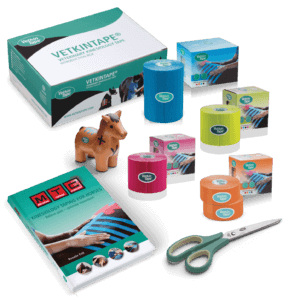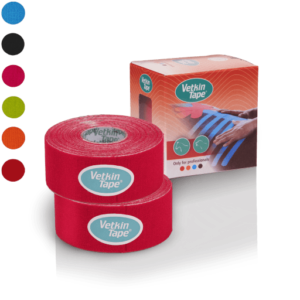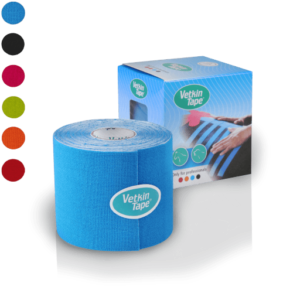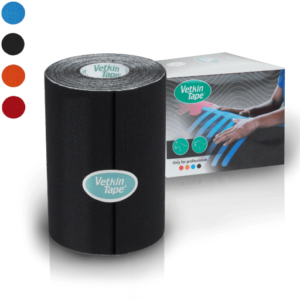Equine kinesiology tape is an elastic & adhesive veterinary kinesiology tape is being sold under the brandname VetkinTape® and developed specifically for veterinary (i.e. equine and canine) purposes.
VetkinTape® is used by veterinary physiotherapists and other veterinary professionals to:
- relieve pain,
- improve muscle function,
- blood circulation & lymphatic flow,
- support joints.
Development of equine kinesiology tape
Therapists treating animals in 2007 began to apply this taping method to animals achieving especially good results in horses. It was then discovered that human kinesiology tape needed to be further developed making it suitable for the veterinary market. Factors like improved adhesion to an animals coat was one such area of research and development.
CureTape® is produced and developed in its own factory in South Korea. By seeking collaboration with experts from the veterinary industry THYSOL has managed to develope a specialized kinesiology tape especially suitable for animals branded VetkinTape®. This product makes THYSOL unique in the kinesiology market. How is taping equine different to taping humans?
History of kinesiology taping
Elastic tape was developed in the 1970s in Japan. The method originated from the principles of the ‘Kinematics’ known under the english term ‘Kinesiology’. Created in Japan this therapy was later practiced and expanded upon in Korea.
This tape is different than normal white athletic tape. Upon application the kinesiotape alleviates muscle strain in order to activate the self-healing ability of the body. The “lifting” effect of the tape on the skin causes various sensory systems in the body are activated which provides immediate improvement in function that allows for a faster recovery from various injuries and complaints.
In the late 90s THYSOL (now thoroughly acquainted with this revolutionary method of taping) began training therapists in Europe through MTC® (Medical Taping Concept).
In 2003 THYSOL developed and registered its own brand of kinesiology tape, CureTape®. Since then the use of CureTape® for kinesiology taping and the associated and associated MTC® taping method has become common amongst therapists in the Netherlands with approximately 72% of the physiotherapy practices offering taping as a form of treatment. After general physiotherapy, kinesiology taping is the most commonly used form of therapy in physiotherapy feilds. What a great result for a relatively new treatment method! During general physiotherapy immediate results can achieve by taping. The direct effect of medical taping experienced by therapists and their patients alike is extremely positive.
Do these results indicate taping is a positive adjunct to your existing methods of treatment?
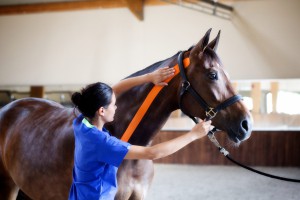

How does equine kinesiology tape affect horses?
In human application the tape lifts the skin creating ‘convelutions’ which stimulating a positive response in the underlying tissue. This paves the way for the self-healing ability of the body to turn on resulting in more rapid recovery of various health complaints. When treating humans with a heavy covering of body hair we recommend shaving the patients area to be treated firts prior to application of kinesiology tape.
Why don’t we shave animals when applying equine kinesiology tape?
VetkinTape® will adhere best to thin or shaved fur (but entirely waxing really is not necessary!) if the coat is extremely thick, curly or long trimming the coat will yield better results. A coat that is dust and grease free will also allow the tapes properties to work better. Once affixed to a short coat, this special tape for horses (VetkinTape®) forms an extension through the hairs roots sending signals to the skin allowing various systems to work in the body as it does in humans. Kinesiology tape treatment on animals greatly enhances the effect other treatments oapplied by the therapist. The equine kinesiology tape will adhere to the coat an average between 3 to 5 days on the horse, depending on the area to taped, temperature, climatic conditions etc.
Shop VetkinTape® online
More and more animal health professionals choose to use VetkinTape in their equine and canine physiotherapy treatments. See our range of VetkinTape® at our online shop.

MTC® Equine kinesiology taping course for veterinarians and animal physiotherapists
At MTC® during our 2 day training course you can learn all the principles and many techniques for applying kinesiology tape to alleviate animal suffering and improve health in an animal physiotherapist or veterinarian practice. The practitioner must have a good knowledge of animal anatomy and have had experience in determining alments animals commonly are afflicted by. Entering the course with this foundation will allow for the best end results for the therapist wishing to offer a total treatment. For course information, please refer to the training section of our website MTC® courses for veterinarians and animal physiotherapists
Common uses for VetkinTape® kinesiology tape;
- The activation of the blood and lymph circulation associated with swelling and bruising
- Influencing fascial structures
- Scar minimization and treatment
- Tendon injuries and inflammation
- Treatment of musculoskeletal injuries
- Improving muscle function and ROM (increase or decrease tone)
Features of VetkinTape® kinesiology tape;
- 25% stronger adhesive than human application CureTape® .
- Latex-free with TÜV quality mark.
- 6 cm wide rolls x 5 meters, (1 cm wider than CureTape®).
- Available in orange, black, red and blue.
- Hypoallergenic, waterproof and breathable.
- Specially developed for the veterinary market, (not suitable for human skin).
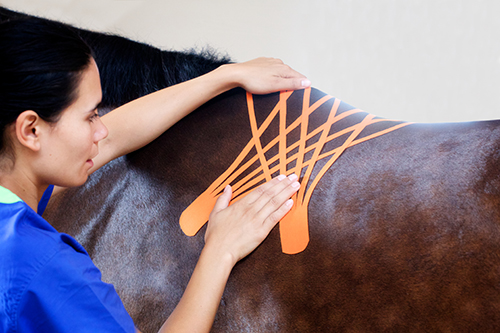
Note: Please note that the specified tape applications and information on our website about the opportunities in the Medical Taping Concept, have not yet been scientifically proven. The statements and examples cited are based on long term experiences of patients and skilled therapists.

